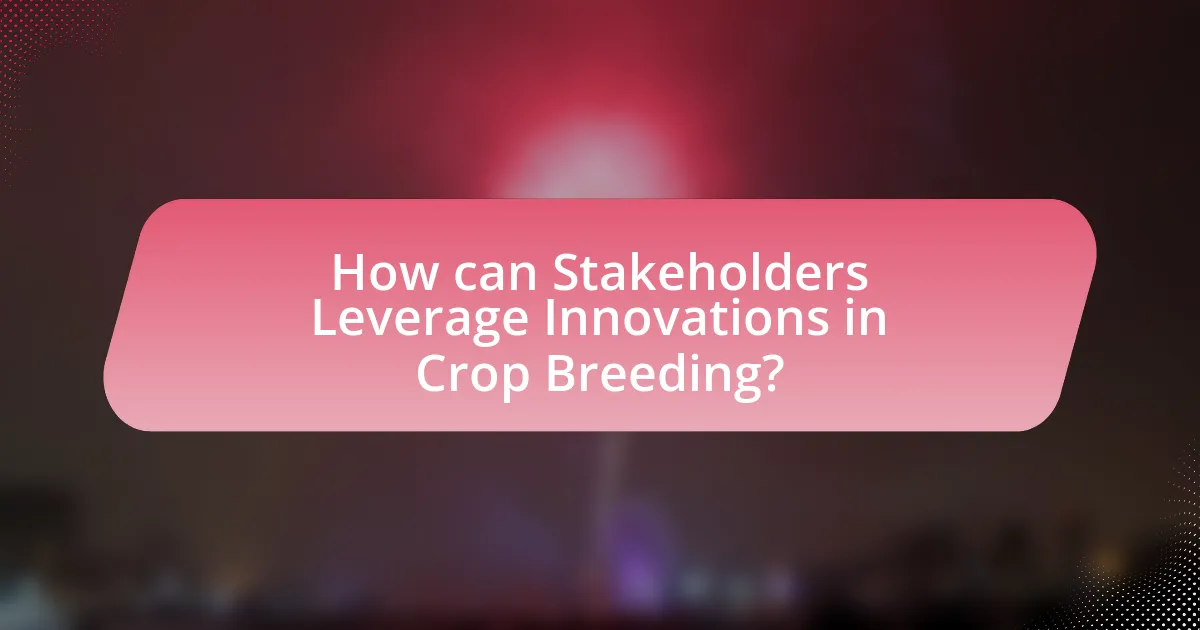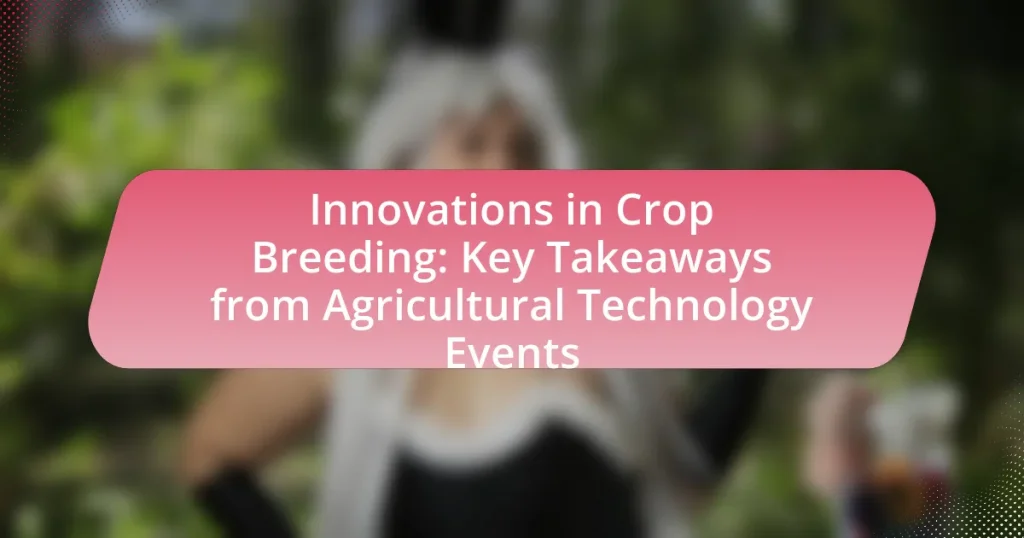Innovations in crop breeding are transforming agricultural practices through advanced techniques such as genetic engineering, CRISPR technology, and marker-assisted selection. These innovations enhance crop resilience to diseases, pests, and climate change, significantly improving yields and sustainability. Key technologies driving these advancements include biotechnology, precision agriculture, and data analytics, which collectively contribute to food security and environmental sustainability. Recent agricultural technology events have highlighted trends such as genomic selection and the integration of artificial intelligence, while also addressing challenges like regulatory hurdles and public acceptance. Stakeholders, including farmers and researchers, are encouraged to collaborate and leverage these innovations to optimize crop breeding and enhance agricultural productivity.

What are Innovations in Crop Breeding?
Innovations in crop breeding encompass advanced techniques such as genetic engineering, marker-assisted selection, and CRISPR technology. These methods enhance the efficiency and precision of developing new crop varieties that are more resilient to diseases, pests, and climate change. For instance, CRISPR technology allows for targeted modifications in the plant genome, significantly speeding up the breeding process compared to traditional methods. According to a study published in Nature Biotechnology, crops developed using CRISPR can achieve desired traits in a fraction of the time and with greater accuracy, demonstrating the transformative impact of these innovations on agricultural productivity and sustainability.
How do these innovations impact agricultural practices?
Innovations in crop breeding significantly enhance agricultural practices by increasing crop yields, improving disease resistance, and enabling better adaptation to climate change. For instance, genetically modified organisms (GMOs) have been shown to increase yields by up to 22% while reducing the need for chemical pesticides, as evidenced by a study published in the journal Nature Biotechnology. Additionally, advancements in precision agriculture technologies allow farmers to optimize resource use, leading to more sustainable practices and reduced environmental impact. These innovations collectively contribute to food security and economic viability in agriculture.
What technologies are driving these innovations?
Biotechnology, precision agriculture, and data analytics are the primary technologies driving innovations in crop breeding. Biotechnology enables genetic modifications that enhance crop traits such as yield and disease resistance. Precision agriculture utilizes GPS and IoT devices to optimize farming practices, leading to more efficient resource use and improved crop performance. Data analytics processes vast amounts of agricultural data to inform breeding decisions and predict outcomes, thereby accelerating the development of new crop varieties. These technologies collectively enhance productivity and sustainability in agriculture, as evidenced by the increased adoption of genetically modified organisms (GMOs) and the growth of data-driven farming practices in recent years.
How do innovations in crop breeding enhance food security?
Innovations in crop breeding enhance food security by developing crop varieties that are more resilient to environmental stresses, pests, and diseases. These advancements lead to increased agricultural productivity, which is essential for feeding a growing global population. For instance, the introduction of drought-resistant maize varieties has been shown to improve yields by up to 30% in arid regions, thereby ensuring a more stable food supply. Additionally, biofortified crops, such as iron-enriched beans, address micronutrient deficiencies, further contributing to nutritional security. These innovations are critical as they help mitigate the impacts of climate change and ensure that food systems can adapt to future challenges.
Why is crop breeding innovation important for sustainability?
Crop breeding innovation is crucial for sustainability because it enhances the resilience and productivity of crops in the face of climate change and resource limitations. By developing varieties that require fewer inputs, such as water and fertilizers, crop breeding can significantly reduce the environmental impact of agriculture. For instance, research has shown that drought-resistant crops can increase yields by up to 50% in arid regions, thereby supporting food security while minimizing resource use. Additionally, innovations in breeding techniques, such as CRISPR and marker-assisted selection, enable faster development of crops that can withstand pests and diseases, further contributing to sustainable agricultural practices.
What role does genetic diversity play in crop breeding?
Genetic diversity is crucial in crop breeding as it enhances resilience, adaptability, and yield potential of crops. By incorporating a wide range of genetic traits, breeders can develop varieties that are better suited to withstand diseases, pests, and changing environmental conditions. For instance, research has shown that crops with higher genetic diversity can yield up to 20% more in adverse conditions compared to those with limited genetic variation. This diversity also facilitates the introduction of beneficial traits, such as drought resistance and improved nutritional content, which are essential for food security in a changing climate.
How can innovations reduce the environmental impact of agriculture?
Innovations can reduce the environmental impact of agriculture by introducing sustainable practices and technologies that enhance efficiency and minimize resource use. For example, precision agriculture utilizes data analytics and GPS technology to optimize planting, watering, and fertilization, which can lead to a reduction in water usage by up to 30% and a decrease in fertilizer application by 20%, thereby lowering runoff and pollution. Additionally, advancements in crop breeding, such as the development of drought-resistant and pest-resistant varieties, can lead to higher yields with less chemical input, further decreasing the ecological footprint of farming. These innovations collectively contribute to more sustainable agricultural practices that protect ecosystems while maintaining productivity.

What are the Key Takeaways from Recent Agricultural Technology Events?
Key takeaways from recent agricultural technology events include the increasing adoption of precision agriculture, advancements in genetic engineering, and the integration of artificial intelligence in farming practices. Precision agriculture technologies, such as drones and IoT sensors, enhance crop monitoring and resource management, leading to improved yields and reduced waste. Genetic engineering breakthroughs, particularly in CRISPR technology, enable the development of crops with enhanced traits like drought resistance and pest tolerance. Additionally, the use of artificial intelligence for data analysis and predictive modeling is transforming decision-making processes in agriculture, optimizing operations and increasing efficiency. These insights reflect the ongoing evolution in agricultural practices aimed at sustainability and productivity.
What trends in crop breeding were highlighted at these events?
Recent agricultural technology events highlighted several key trends in crop breeding, including the increased use of genomic selection, CRISPR gene editing, and sustainable practices. Genomic selection allows breeders to predict the performance of plants based on their genetic makeup, significantly speeding up the breeding process. CRISPR technology enables precise modifications to plant genomes, enhancing traits such as disease resistance and yield. Additionally, there is a growing emphasis on sustainable breeding practices that focus on environmental resilience and resource efficiency, aligning with global goals for sustainable agriculture. These trends reflect a shift towards more innovative and efficient methods in crop breeding, aimed at addressing food security and climate change challenges.
Which innovations received the most attention from experts?
The innovations that received the most attention from experts in crop breeding include CRISPR gene editing, precision agriculture technologies, and drought-resistant crop varieties. CRISPR gene editing has revolutionized the ability to modify plant genomes with high specificity, allowing for rapid development of crops with desirable traits. Precision agriculture technologies, such as satellite imaging and soil sensors, enhance crop management by providing real-time data for optimizing inputs and improving yields. Drought-resistant crop varieties are increasingly critical due to climate change, as they help ensure food security in arid regions. These innovations are supported by numerous studies and presentations at agricultural technology events, highlighting their significance in modern agriculture.
How are industry leaders responding to these trends?
Industry leaders are responding to trends in crop breeding innovations by investing in advanced technologies such as CRISPR gene editing and precision agriculture tools. These investments aim to enhance crop resilience, improve yield efficiency, and reduce environmental impact. For instance, companies like Bayer and Syngenta are actively developing genetically modified crops that can withstand climate variability, which is crucial given that the global population is projected to reach 9.7 billion by 2050, necessitating a 70% increase in food production. Additionally, industry leaders are collaborating with research institutions to accelerate the development of sustainable agricultural practices, as evidenced by partnerships formed during recent agricultural technology events.
What challenges were discussed regarding crop breeding innovations?
Challenges discussed regarding crop breeding innovations include regulatory hurdles, public acceptance, and the need for funding. Regulatory hurdles arise from complex approval processes that can delay the introduction of new varieties. Public acceptance is often influenced by concerns over genetically modified organisms, which can hinder the adoption of innovative breeding techniques. Additionally, securing adequate funding for research and development is critical, as many breeding programs require significant investment to advance technologies and achieve desired outcomes. These challenges collectively impact the pace and effectiveness of crop breeding innovations in addressing food security and sustainability.
How do regulatory frameworks affect innovation in crop breeding?
Regulatory frameworks significantly influence innovation in crop breeding by establishing guidelines that can either facilitate or hinder research and development. For instance, stringent regulations may slow down the approval process for new crop varieties, limiting the ability of breeders to bring innovative products to market quickly. Conversely, supportive regulatory environments, such as those that streamline the approval process for genetically modified organisms (GMOs), can accelerate innovation by allowing faster access to new technologies. Evidence from countries with more flexible regulatory systems, like the United States, shows that these systems can lead to increased investment in agricultural biotechnology, resulting in a wider array of crop varieties and improved agricultural productivity.
What are the barriers to adopting new technologies in agriculture?
The barriers to adopting new technologies in agriculture include high costs, lack of access to information, insufficient infrastructure, and resistance to change among farmers. High costs can deter farmers from investing in new technologies, as many innovations require significant upfront capital. Lack of access to information limits farmers’ understanding of available technologies and their benefits, while insufficient infrastructure, such as inadequate internet connectivity, hampers the implementation of digital solutions. Additionally, resistance to change stems from traditional farming practices and skepticism about the effectiveness of new methods, which can slow down the adoption process. These factors collectively hinder the integration of innovative technologies in agricultural practices.

How can Stakeholders Leverage Innovations in Crop Breeding?
Stakeholders can leverage innovations in crop breeding by adopting advanced genetic techniques such as CRISPR and marker-assisted selection to enhance crop traits. These innovations enable stakeholders to develop varieties that are more resilient to climate change, pests, and diseases, thereby increasing agricultural productivity. For instance, research has shown that CRISPR technology can improve drought tolerance in crops, which is crucial as global temperatures rise. Additionally, stakeholders can collaborate with research institutions and technology providers to access the latest breeding tools and methodologies, ensuring they remain competitive in the agricultural sector.
What strategies can farmers adopt to implement these innovations?
Farmers can adopt several strategies to implement innovations in crop breeding effectively. First, they should engage in continuous education and training to stay updated on the latest breeding techniques and technologies, such as CRISPR and genomic selection. Research indicates that farmers who participate in workshops and training programs are more likely to adopt new practices, as seen in studies conducted by the International Food Policy Research Institute, which found a 30% increase in adoption rates among trained farmers.
Additionally, farmers can collaborate with agricultural extension services and research institutions to gain access to expert knowledge and resources. This collaboration can facilitate the sharing of best practices and innovations tailored to local conditions. Furthermore, forming cooperatives can enable farmers to pool resources for purchasing advanced breeding technologies and sharing the costs associated with implementation.
Lastly, utilizing data analytics and precision agriculture tools can help farmers make informed decisions about crop selection and management, leading to improved yields and sustainability. A study by the Food and Agriculture Organization highlights that precision agriculture can increase crop productivity by up to 20% through optimized resource use.
How can collaboration between researchers and farmers enhance crop breeding?
Collaboration between researchers and farmers enhances crop breeding by integrating scientific knowledge with practical farming experience. This partnership allows researchers to develop crop varieties that are not only scientifically advanced but also tailored to the specific needs and conditions faced by farmers. For instance, a study published in the journal “Field Crops Research” demonstrated that participatory breeding programs, where farmers actively engage in the selection process, resulted in higher adoption rates of new varieties and improved crop yields. By leveraging local knowledge and addressing real-world challenges, such collaborations lead to more resilient and productive crops, ultimately benefiting both agricultural productivity and food security.
What resources are available for farmers to learn about new technologies?
Farmers can access various resources to learn about new technologies, including agricultural extension services, online courses, webinars, and industry conferences. Agricultural extension services provide localized support and information on the latest technologies and practices. Online platforms like Coursera and edX offer courses specifically tailored to agricultural advancements. Webinars hosted by agricultural organizations and universities allow farmers to engage with experts and learn about innovations in real-time. Additionally, industry conferences, such as the International Conference on Agriculture and Horticulture, showcase cutting-edge technologies and provide networking opportunities for farmers to connect with technology providers and peers.
What best practices should be followed for successful crop breeding innovation?
Successful crop breeding innovation requires a systematic approach that includes utilizing advanced genetic techniques, maintaining genetic diversity, and engaging with stakeholders. Advanced genetic techniques, such as CRISPR and marker-assisted selection, enhance precision in breeding, allowing for the development of crops with desired traits more efficiently. Maintaining genetic diversity is crucial as it provides a broader gene pool, which can improve resilience to pests and diseases, as evidenced by studies showing that diverse crops are more adaptable to changing environmental conditions. Engaging with stakeholders, including farmers, researchers, and consumers, ensures that breeding programs align with market needs and sustainability goals, as highlighted in the Food and Agriculture Organization’s guidelines on participatory breeding.
How can data analytics improve decision-making in crop breeding?
Data analytics can significantly enhance decision-making in crop breeding by providing insights derived from large datasets on plant genetics, environmental conditions, and yield performance. By analyzing this data, breeders can identify traits associated with higher yields or disease resistance, allowing for more targeted selection of parent plants. For instance, a study published in the journal “Nature Biotechnology” demonstrated that data-driven approaches could increase the efficiency of breeding programs by up to 30%, as they enable breeders to make informed decisions based on predictive models rather than trial-and-error methods. This leads to faster development of improved crop varieties that meet the demands of changing climates and consumer preferences.
What role does education play in advancing crop breeding techniques?
Education plays a crucial role in advancing crop breeding techniques by equipping individuals with the necessary knowledge and skills to innovate and improve agricultural practices. Through formal education programs, such as degrees in plant science or agricultural biotechnology, students learn about genetics, plant physiology, and breeding methodologies, which are essential for developing new crop varieties. Research indicates that countries with strong agricultural education systems, like the United States and the Netherlands, have seen significant advancements in crop yields and sustainability due to the application of modern breeding techniques. For instance, the introduction of genetically modified organisms (GMOs) has been largely driven by educated professionals who understand the complexities of genetic engineering and its implications for food security.















